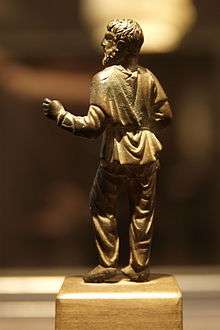Braccae

Braccae is the Latin term for trousers, and in this context is today used to refer to a style of trousers, made from wool. The Romans encountered this style of clothing among peoples whom they called Galli (Gauls).[1] This is often assumed to mean speakers of Celtic languages, though many scholars (including John Collis[2] and Peter S Wells[3]) doubt that the term Galli was primarily based on linguistic affiliation.
Braccae were typically made with a drawstring, and tended to reach from just above the knee at the shortest, to the ankles at the longest, with length generally increasing in tribes living further north.
When the Romans first encountered the braccae, they thought them to be effeminate (Roman men typically wore tunics, which were one-piece outfits terminating at or above the knee).
Etymology
The word is cognate with the English breeches. It appears to derive from the Indo-European root *bhrg- 'break', here apparently used in the sense 'divide', 'separate'. The consonant sequence *b.r.k implies an origin in the Germanic (with regular sound change *g > *k) rather than the Celtic branch of the Indo-European languages; Celtic would regularly have *b.r.g instead, as in Scottish Gaelic briogais or in Breton bragoù. The form *b.r.k is well attested in Germanic languages (Proto-Germanic *brōkiz, see breeches).
If the Romans learnt this word from Celtic-speakers, it seems odd that the Latin word has cc, apparently resembling the Germanic form with *k, rather than the Celtic form, with *g. There are several possible explanations:
- The Romans first heard the word from Celtic-speakers, who had borrowed it from Germanic-speakers.
- The Romans first heard the word from Germanic-speakers.
- The Romans first heard a form with Celtic *g, but the pronunciation that they came to use in imitation did not accurately reflect what they originally heard.
- The Celtic word first passed to the Etruscans, who did not distinguish between the "c" and "g" sounds. Transition through the Etruscans accounts for the Greek amorge being rendered as Latin amurca, Greek κυβερνἂν (kubernân) as Latin gubernare. Perhaps that is how "bragae" became "bracae" and then "braccae".
Notes
- ↑ Diodorus Siculus, Bibliotheca Historica
- ↑ Collis, John (2003). The Celts: Origins, Myths, Inventions, Tempus. ISBN 0-7524-2913-2
- ↑ Wells, Peter S (2001). Beyond Celts, Germans and Scythians, Duckworth Debates in Archaeology. ISBN 0-7156-3036-9